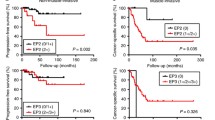Abstract
Objective
The objective of the study was to illustrate the applicability and significance of the novel Lewis urothelial cancer model compared to the classic Fisher 344.
Methods
Fischer 344 and Lewis females rats, 7 weeks old, were intravesical instilled N-methyl-N-nitrosourea 1.5 mg/kg every other week for a total of four doses. After 15 weeks, animals were sacrificed and bladders analyzed: histopathology (tumor grade and stage), immunohistochemistry (apoptotic and proliferative indices) and blotting (Toll-like receptor 2—TLR2, Uroplakin III—UP III and C-Myc). Control groups received placebo.
Results
There were macroscopic neoplastic lesions in 20 % of Lewis strain and 70 % of Fischer 344 strain. Lewis showed hyperplasia in 50 % of animals, normal bladders in 50 %. All Fischer 344 had lesions, 20 % papillary hyperplasia, 30 % dysplasia, 40 % neoplasia and 10 % squamous metaplasia. Proliferative and apoptotic indices were significantly lower in the Lewis strain (p < 0.01). The TLR2 and UP III protein levels were significantly higher in Lewis compared to Fischer 344 strain (70.8 and 46.5 % vs. 49.5 and 16.9 %, respectively). In contrast, C-Myc protein levels were significantly higher in Fischer 344 (22.5 %) compared to Lewis strain (13.7 %).
Conclusions
The innovative Lewis carcinogen resistance urothelial model represents a new strategy for translational research. Preservation of TLR2 and UP III defense mechanisms might drive diverse urothelial phenotypes during carcinogenesis in differently susceptible individuals.



Similar content being viewed by others
References
Crallan RA, Georgopoulos NT, Sothgate J (2006) Experimental models of human bladder carcinogenesis. Carcinogenesis 27:374–381
Reis LO, Pereira TC, Fávaro WJ, Cagnon VHA, Lopes-Cendes I, Ferreira U (2009) Experimental animal model and RNA interference: a promising association for bladder cancer research. World J Urol 27:353–361
Ogawa K, Sun T-T, Cohen SM (1996) Analysis of differentiation associated proteins in rat bladder carcinogenesis. Carcinogenesis 17:961–965
Kunze E, Graewe T, Scherber S (1989) Cell cycle dependence of N-methyl-N-nitrosourea-induced tumour development in the proliferating partially resected rat urinary bladder. Br J Exp Pathol 70:125–142
Reis LO, Fávaro WJ, Ferreira U et al (2010) Evolution on experimental animal model for upper urothelium carcinogenesis. World J Urol 28:499–505
Reis LO, Sopena JM, Fávaro WJ, Martin MC, Simão AF, Reis RB, Andrade MF, Domenech JD, Cardo CC (2011) Anatomical features of the urethra and urinary bladder catheterization in female mice and rats. An essential translational tool. Acta Cir Bras 26(Suppl 2):106–110
Reis LO, Ferreira U, Billis A, Cagnon VH, Fávaro WJ (2012) Anti-angiogenic effects of the superantigen staphylococcal enterotoxin B and bacillus Calmette-Guérin immunotherapy for nonmuscle invasive bladder cancer. J Urol 187(2):438–445
Epstein JI, Amin MB, Reuter VR, Mostofi FK, the Bladder Consensus Conference Committee (1998) The World Health Organization/International Society of Urological Pathology consensus classification of urothelial (transitional cell) neoplasms of the urinary bladder. Am J Surg Pathol 22:1435–1448
Takahara E, Nagata O, Kato H, Ohta S, Hirobe M (1993) Inter-individual differences of (+)-4-[4-(4-methylphenyl)phenylmethoxy-1-piperidinyl] butyric acid ((+)-MPPB) disposition in rats. Biol Pharm Bull 16:1057–1059
Rakoff-Nahoum S, Medzhitov R (2009) Toll-like receptors and cancer. Nat Rev Cancer 9:57–63
Ayari C, Bergeron A, LaRue H, Ménard C, Fradet Y (2011) Toll-like receptors in normal and malignant human bladders. J Urol 185:1915–1921
Fávaro WJ, Nunes OS, Seiva FR, Nunes IS, Woolhiser LK, Durán N, Lenaerts AJ (2012) Effects of P-MAPA Immunomodulator on Toll-like receptors and p53: potential therapeutic strategies for infectious diseases and cancer. Infect Agent Cancer 7(1):14
Ogawa K, St John M, Luiza de Oliveira M, Arnold L, Shirai T, Sun TT, Cohen SM (1999) Comparison of uroplakin expression during urothelial carcinogenesis induced by N-butyl-N-(4-hydroxybutyl)nitrosamine in rats and mice. Toxicol Pathol 27(6):45–51
Jeong KC, Kim KT, Seo HH, Shin SP, Ahn KO, Ji MJ, Park WS, Kim IH, Lee SJ, Seo HK (2013) Intravesical instillation of c-MYC inhibitor KSI-3716 suppresses orthotopic bladder tumor growth. J Urol. doi:10.1016/j.juro.2013.07.019
Hicks RM, Wakefield JS (1972) Rapid induction of bladder cancer in rats with N-methyl-N-nitrosourea. I. Histology. Chem Biol Interact 5:139–152
Steinberg GD, Brendler CB, Squire RA (1991) Experimental intravesical therapy for superficial transitional cell carcinoma in a rat bladder tumor model. J Urol 145:647–653
Mashimo Tomoji, Voigt Birger, Kuramoto Takashi, Serikawa Tadao (2005) Rat Phenome Project: the untapped potential of existing rat strains. J Appl Physiol 98:371–379
Billingham RE, Silvers WK (1959) Inbred animals and tissue transplantation immunity, with an index of some inbred strains other than mice. Transpl Bull 6:399–406
Conflict of interest
Authors declare no conflict of interest.
Author information
Authors and Affiliations
Corresponding author
Rights and permissions
About this article
Cite this article
Reis, L.O., Ferrari, K., Zamuner, M. et al. Urothelial carcinogen resistance driven by stronger Toll-like receptor 2 (TLR2) and Uroplakin III (UP III) defense mechanisms: a new model. World J Urol 33, 413–419 (2015). https://doi.org/10.1007/s00345-014-1329-y
Received:
Accepted:
Published:
Issue Date:
DOI: https://doi.org/10.1007/s00345-014-1329-y




